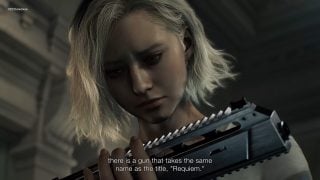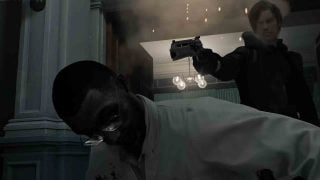Capcom’s fighting game output was legendary from the very beginning. It’s why they can get away with having multiple, sometimes overlapping, genre compilations readily available this console generation. That’s not a complaint in the slightest – I’ll keep eating these collections up, as they bring back old favorites and let us discover new ones. Even with access to Third Strike and Darkstalkers on Switch, a particular family of games was becoming increasingly more conspicuous in its absence.
The Marvel vs. Capcom series is both peak fighter and crossover, bringing together two unlikely families of characters and creating an entire generation of button-mashing, roster-crafting, Dreamcast-modding fans. These games have a way of coming back, usually only digitally, before getting delisted due to particulars of licensing agreements between the two companies. Despite that relative scarcity, they continue to be some of the most beloved, with devotees rallying behind hashtags and campaigns to save these games.
Thankfully the powers that be listened, and the Marvel vs. Capcom Fighting Collection: Arcade Classics is doing just that. Seven games are coming back, ranging from absolute icons to “wait, The Punisher had an arcade game?”. If it’s not already apparent, I was sold on this set from the moment it was announced. Read on to find out why you don’t want to miss out on what might be one of the best Capcom compilations yet.
Looking purely at the included fighting games, this stands as an impressive and comprehensive collection:
- X-Men: Children of the Atom
- Marvel Super Heroes
- X-Men vs. Street Fighter
- Marvel Super Heroes vs. Street Fighter
- Marvel vs. Capcom: Clash of Super Heroes
- Marvel vs. Capcom 2: New Age of Heroes
Put another way, you get nearly the entire Marvel vs. Capcom arcade legacy in one package, missing only the more modern HD titles Marvel vs. Capcom 3 and Marvel vs. Capcom Infinite. Being able to trace the line (and reused sprites) from CotA all the way to MvC2 in one collection is incredible, particularly compared to previous releases (and omissions) of these games.
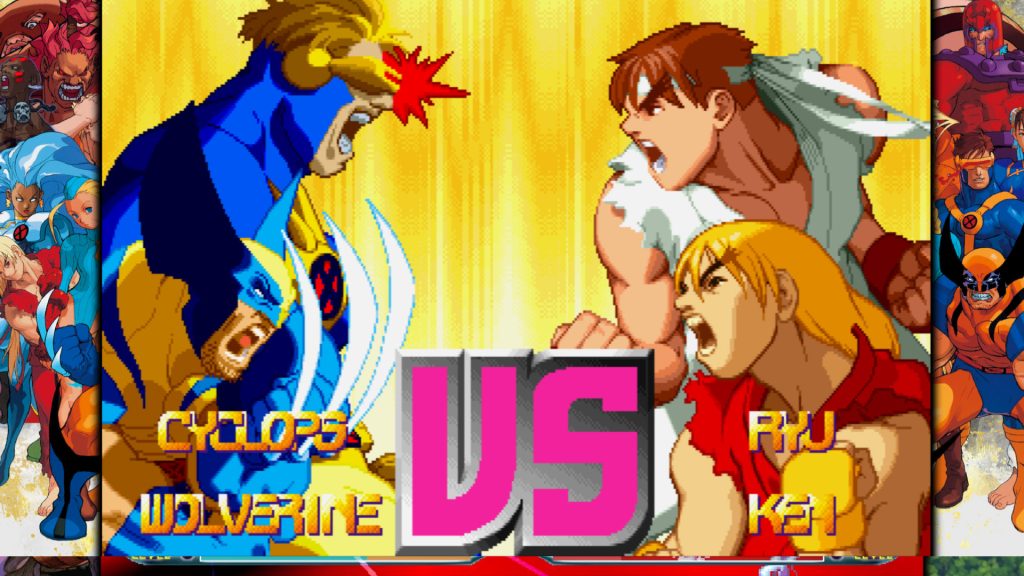
The game most likely to draw people in here is no doubt MvC2. This is a game that defined the genre for a generation of players and stands as a gold standard for tag-team, assist-based fighters. It’s hard to imagine the modern fighting game community without this game’s influence and continued popularity for nearly 25 years. It doesn’t matter that it’s famously unbalanced or that the Marvel half of the roster is overwhelmingly composed of mutants – this is one of the greatest and most important fighting games ever made. Having it readily available on multiple platforms (with a physical version slated for November 22nd) once again helps it avoid the licensing woes inherent to the series, and lays the groundwork for a potential continuation.
And hey, if we got this and have another fantastic lineup on the horizon thanks to Capcom Fighting Collection 2, maybe we can still get JoJo back…some day…
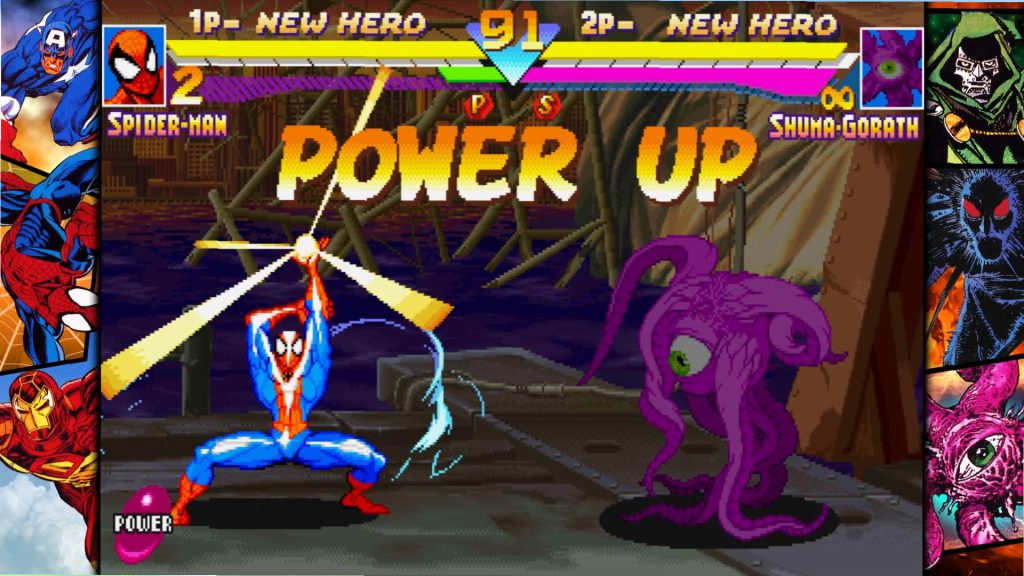
Even with the heaps of praise for Marvel 2, it wouldn’t exist without the other titles of this collection and they all deserve attention on their own merits. No offense to the strangest heroes of all, but both Children of the Atom and X-Men vs. Street Fighter felt a bit lacking. This isn’t down to their narrower roster focus and more so because they represent the “first entries” for Marvel fighters and MvC-like crossovers as a whole respectively. They’re relatively straightforward and later entries in the collection grow on their foundations. This unfortunately makes them feel outdated, though not invalidated – their inclusion for completion’s sake is welcome.
I’d say the same for Marvel Super Heroes, but it gets to occupy a unique space thanks to its use of the Infinity Gems as a mechanic and more apparent narrative. It’s thanks to this game and its influence on future fighters that I actually knew who Thanos was when the first Avengers movie released, as it too pulls from the original Infinity Gauntlet storyline. As you play through arcade mode you’ll be able to use Gems to power up, granting passives or more unique activations depending on your chosen character. It gives revisiting this particular game some added legs compared to the other “early” titles. It also marks the first instance of Capcom insisting the obscure Dr. Strange villain Shuma-Gorath appear in these games, and for that I’ll be eternally thankful – a waste of flesh it was not.
As far as the other crossovers go, Marvel Super Heroes vs. Street Fighter gets points mostly for introducing assists to the series and oddities like Cyber Akuma. Its gameplay can still feel a little rough around the edges, but it paved the way for what actually ended up my most played entry during this review period.
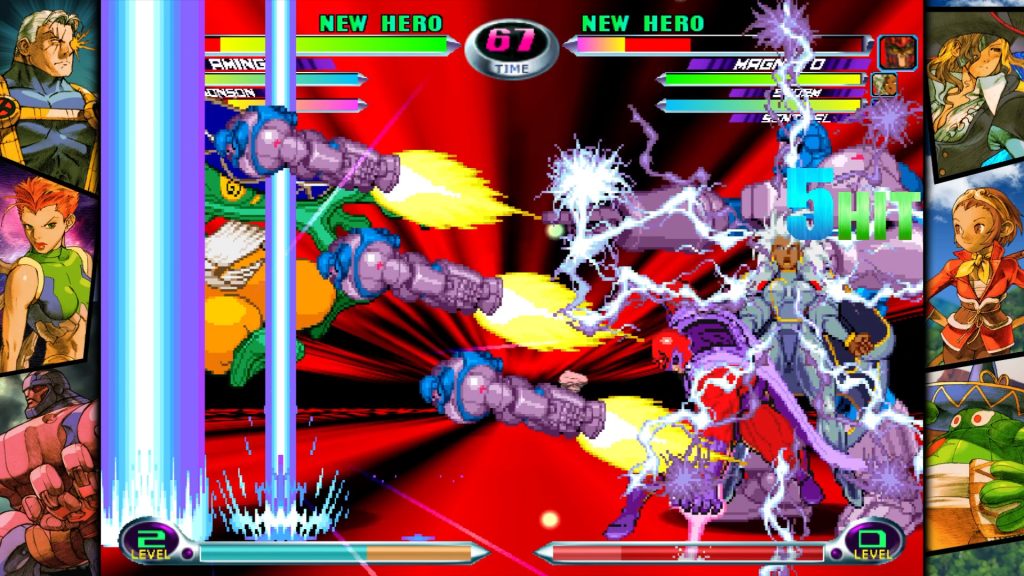
The first Marvel vs. Capcom game is one I’d put an okay amount of time into in arcades, but by the time I was frequenting it was fully eclipsed by its bigger, flashier sequel. Giving it more time and a critical perspective, I was actually impressed with several elements that ended up dropped in MvC2. Its presentation, such as the character select screen and hyper combo cut-ins, feel more “on brand”. Its stages and music are more inspired by the roster, making it feel more like a crossover as they’re typically perceived today (rather than by sheer size, as could be the case in the past).
I was also into its take on assists, having them be “guest characters” rather than tied to your tag-team partner. Capcom’s half of those in particular are some deep, deep cuts. I doubt Capcom would go back to that structure, as the MvC2 style of variable assists offers way more customization and gameplay depth, but for sheer fanservice these felt almost like proto-Assist Trophies. Plus, Onslaught is a way better final boss than Abyss ever was.
In a lot of ways MvC1 feels like the arcade peak of these games’ identity while MvC2 feels like the peak of their gameplay. If you pull the lens back and include MvC3 and MvCI in the conversation you’ll see elements of the first Marvel vs. Capcom slowly crept back in while keeping the pace, scale, and intricacies of New Age of Heroes. It’s thanks to those later games, as well as the earlier titles found in this set, that I walked away with a new found appreciation of Clash of Super Heroes – the perfect turning point of this legacy and well worth revisiting.
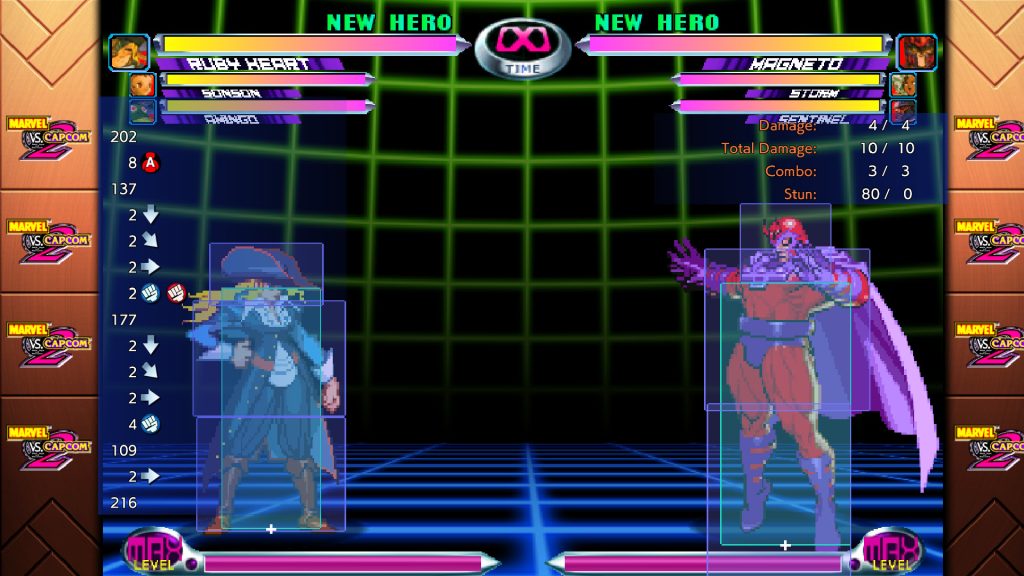
If these were all straight ports the Marvel vs. Capcom Fighting Collection would still be a great compilation, but thankfully Capcom has brought its usual suite of extras like music and art galleries, in game achievements, and options like quick saves and display adjustments. The fighting game centric additions are just as welcome: the addition of online multiplayer and training rooms may be genre-standard now but most of these titles have never had them.
I want to make note specifically of the rosters of these games too. Players are able to access characters like Juggernaut and Magneto in Children of the Atom, Doctor Doom and Thanos in Marvel Super Heroes, and the famously strange guest character Norimaro via the included Japanese version of Marvel vs. Street Fighter. Other secret characters in the various titles are also available right from the start while also having optional toggles to remove access to them if desired, making this a tournament-ready package on start up.
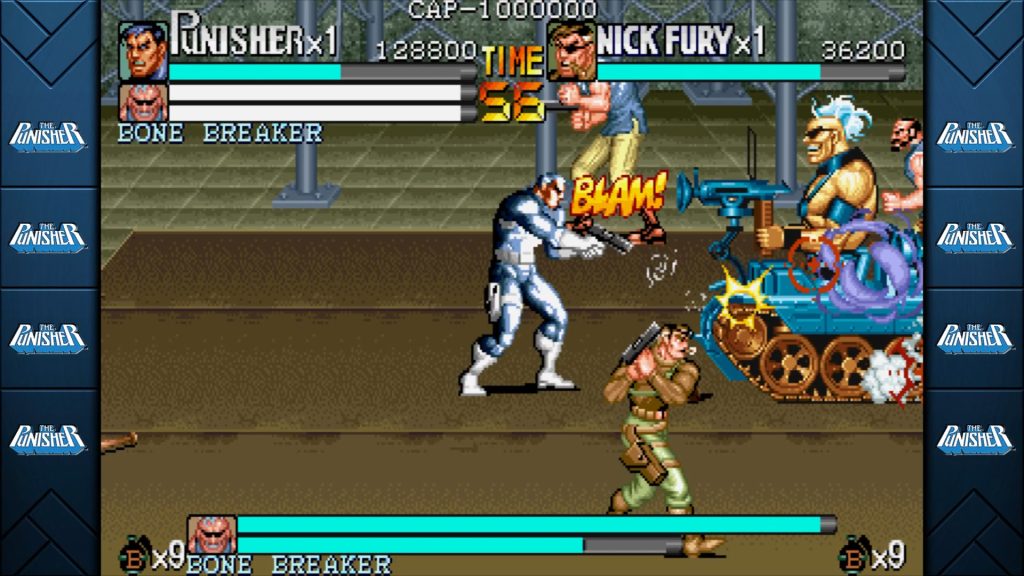
The biggest surprise out of this collection was how much I enjoyed its most obscure inclusion. The Punisher was the first time Capcom worked with Marvel on a video game, letting it fit right in here even if it’s not a fighter. I went in with minimal familiarity of this hidden arcade gem, and walked away ranking it alongside Final Fight and Battle Circuit as an incredible example of what Capcom did with the beat ‘em up genre.
Playing as either Frank Castle or Nick Fury, you’ll punch, kick, stab, and shoot your way through stages in pursuit of taking down the Kingpin. As a framework it’s pretty typical, but it uses the characters and Marvel’s street-level underworld well – about the “weirdest” it gets are a handful of cyborg enemies but even they “work” within this corner of the comics’ universe. The most notable gimmick is that when gun-wielding thugs are on screen, your character of choice will pull out a pistol with infinite ammo to fight back with. It doesn’t reinvent the belt action wheel, but it does a good job of changing things up and giving you a break from brawling.
About the only complaint I can think of for The Punisher is the amount of deaths I racked up over a playthrough, which is more genre wide and a byproduct of its arcade origin than specific to this game and fully mitigated by it not costing quarters to keep playing. The sprites and animations are solid (I’m a sucker for Frank firing off a few rounds whenever he’s revived on the continue screen) and there are some fantastic music tracks courtesy of Yoko Shimomura herself. It’s brief enough to play through in a single sitting and absolutely worthy of rubbing shoulders with the rest of this collection. Don’t sleep on this one!
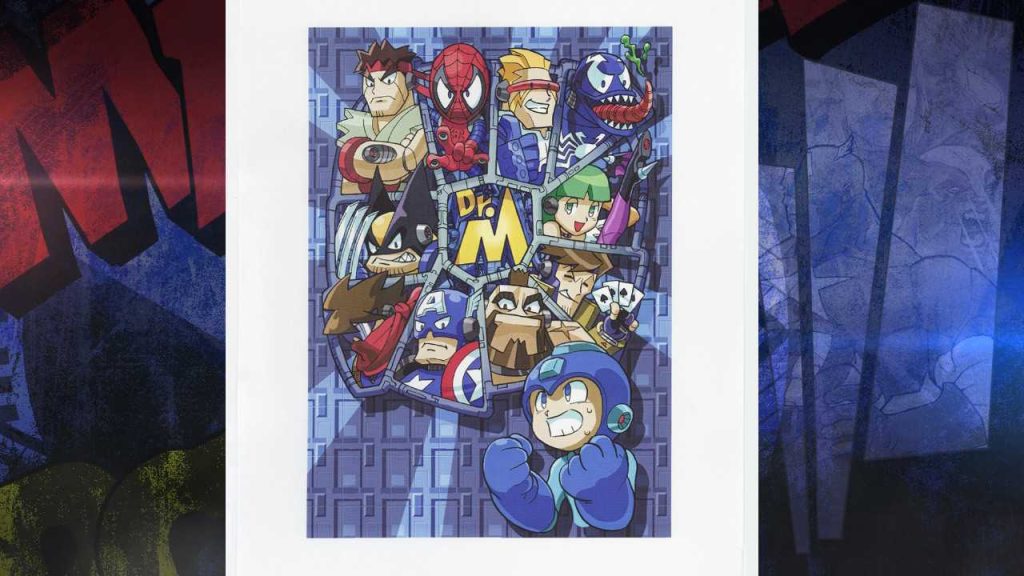
I’ve given plenty of praise to Capcom’s fighting collections in the past, and with good reason. I’ve been a longtime fan of not just the company’s output in this particular genre and across the board. What’s more distinct here, however, is that these particular games may be the root of my love for the company’s characters beyond Street Fighter. At the time I wouldn’t have known who Jin Saotome, Tron Bonne, or B.B. Hood were without these games. That approachability came from the Marvel half of the equation, with its instantly familiar lineup of super heroes, not to mention just how hype these games can get at all levels of play. To speak more personally and plainly than that, even if I’m nowhere near competitive with it, MvC represents some of the most formative games of my life.
The Marvel vs. Capcom Fighting Collection is peak fighting game in one excellent, accessible package. If you have even a passing interest in the genre you owe it to yourself to pick up these arcade classics. A whole new generation of players raised on the Marvel Cinematic Universe can see those characters in a new light and understand why this has always been a ride worth taking.
Leave a Comment